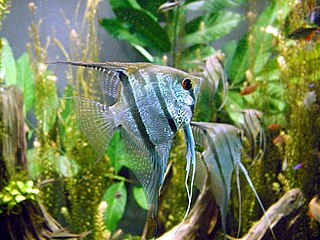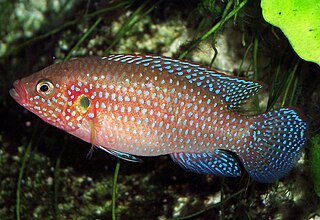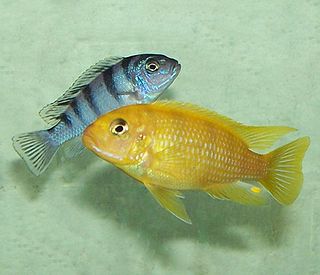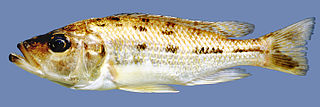
Cichlids are fish from the family Cichlidae in the order Cichliformes. Cichlids were traditionally classed in a suborder, the Labroidei, along with the wrasses (Labridae), in the order Perciformes, but molecular studies have contradicted this grouping. The closest living relative of cichlids is probably the convict blenny, and both families are classified in the 5th edition of Fishes of the World as the two families in the Cichliformes, part of the subseries Ovalentaria. This family is both large and diverse. At least 1,650 species have been scientifically described, making it one of the largest vertebrate families. New species are discovered annually, and many species remain undescribed. The actual number of species is therefore unknown, with estimates varying between 2,000 and 3,000.

Mbuna is the common name for a large group of African cichlids from Lake Malawi, and are members of the haplochromine family. The name mbuna means "rockfish" in the language of the Tonga people of Malawi. As the name implies, most mbuna are cichlids that live among the piles of rocks and along the rocky shores of Lake Malawi, as opposed to the utaka, cichlids that live in the open water or on sandy shores or soft substrates. Some species of mbuna are highly sexually dimorphic, although many are not. Among biologists, almost all of the cichlid species of Lake Malawi, including mbuna and non mbuna such as the utaka, are believed to have descended from one or a very few species that became isolated in the lake. With rising water levels, new habitats could be colonized and the many isolated rocky outcrops allowed new mbuna species to form. Their striking colors, intriguing behavioral characteristics, and relative hardiness make them very popular despite their unique demands for the home aquarist.

Hemichromis is a genus of fishes from the cichlid family, known in the aquarium trade as jewel cichlids. Jewel cichlids are native to Africa. Within West Africa, Hemichromis species are found in creeks, streams, rivers and lakes with a variety of water qualities including brackish water lagoons.

Maylandia estherae is a haplochromine cichlid. It is a rock dwelling fish or mbuna from Lake Malawi. This fish, like most cichlids from Lake Malawi, is a mouthbrooder - females hold their fertilized eggs then fry in their mouths until they are released after about 21 days.

The terms shell dwellers or shelldwellers, shell-breeding, or ostracophil are descriptive terms for cichlid fish that use the empty shells of aquatic snails as sites for breeding and shelter. The terms have no taxonomic basis, although most shell-dwelling cichlids are from Lake Tanganyikas lamprologine lineage. Many shell dwelling cichlids are popular with fishkeepings and are frequently kept in aquaria.

Aulonocara is a genus of haplochromine cichlids endemic to Lake Malawi in East Africa. All Aulonocara species are maternal mouth brooders. Particularly in the aquarium hobby, Aulonocara species are also known as peacock cichlids, aulonocaras or simply "peacocks". This genus is strongly sexually dichromic, even by haplochromine standards.

Maylandia or Metriaclima is a genus of haplochromine cichlids endemic to Lake Malawi in East Africa. They belong to the mbuna (rock-dwelling) haplochromines.

Maylandia lombardoi, is a 13 centimetres (5.1 in) long freshwater fish from the family Cichlidae. This species is popular in the aquarium hobby where it is sold under a variety of common names including: lombardoi mbuna, kenyi mbuna or kennyi mbuna or kenyi cichlid. This species is sometimes seen in the genus Metriaclima owing to a dispute in which a minority of cichlid researchers do not consider Maylandia valid (see Maylandia for discussion. The specific name honours the exotic fish dealer John Lombardo.

Melanochromis is a genus of haplochromine cichlids endemic to Lake Malawi in Eastern Africa. Ecologically, they belong to the rock-dwelling mbuna cichlids of Lake Malawi.

Tropheus is a small genus of at least six species of cichlids endemic to Lake Tanganyika in East Africa. The genus is widespread across all regions of Lake Tanganyika, from Burundi in the north to Zambia in the south. Males and females are relatively similar in color, with only subtle sexual dimorphism in the form of the male's larger size. All species are maternal mouthbrooders, with the females caring for their eggs and fry in their mouths; this characteristic provides their generic name, Tropheus, which comes from the Greek trophos, which means "to nurse" or, according to Boulenger, "one who rears, brings up, educates". The genus is fished lightly by the local population, but has never become a staple food fish due to its relatively small size and its habitat, which enables it to dart between rocks when threatened.

The haplochromine cichlids are a tribe of cichlids in subfamily Pseudocrenilabrinae called Haplochromini. This group includes the type genus (Haplochromis) plus a number of closely related genera such as Aulonocara, Astatotilapia, and Chilotilapia. They are endemic to eastern, southern and northern Africa, except for Astatotilapia flaviijosephi in the Middle East. A common name in a scientific context is East African cichlids – while they are not restricted to that region, they are the dominant Cichlidae there. This tribe was extensively studied by Ethelwynn Trewavas, who made major reviews in 1935 and 1989, at the beginning and at the end of her career in ichthyology. Even today, numerous new species are being described each year.

Diplotaxodon is a small genus of seven formally described, as well as a number of undescribed, deep-water species of cichlid fish endemic to Lake Malawi in east Africa. These fishes represent a remarkable adaptive radiation of offshore and deep-water adapted fish descended from ancestral shallow water forms. They include the dominant zooplankton-feeding fish of the offshore and deep-water regions of the lake, as well as a number of larger species that appear to feed on small pelagic fishes. Adult sizes range from 10 to 30 cm in total length, depending on species.

Iodotropheus sprengerae, the rusty cichlid, lavender mbuna or lavender cichlid, is a species of cichlid endemic to the Boadzulu and Chinyankwazi Islands and Chinyamwezi Island regions of Lake Malawi. It prefers a temperature range of 24-26 °C.

Hemitaeniochromis is a small genus of cichlid fishes endemic to Lake Malawi in east Africa. The genus is distinguished from other genera of Lake Malawi Haplochromini by details of its melanic color pattern and by its dentition. The color pattern includes (1) a midlateral horizontal stripe starting at least an eye length behind the operculum, this stripe broken into separate spots at least on its front half, more nearly continuous on its rear half, extending to the end of the caudal peduncle; (2) a second (supralateral) stripe above the midlateral one that is only on the front part of the flanks, and which is also at least partly broken into spots; (3) above this at the base of the dorsal fin are 4 or 5 dorsal midline spots. The dentition of the jaws is also distinctive in fish at least 10 centimetres in length ; the outer teeth are roughly conical with a single cusp and are spaced apart from each other by about the width of the tooth.

Pseudotropheus johannii or the bluegray mbuna is an African freshwater fish from the family Cichlidae.

The zebra mbuna is a species of cichlid endemic to Lake Malawi in Africa. This species can reach a length of 11.3 cm (4.4 in). It feeds on aufwuchs, a surface layer of mostly algal material that grows on rocks. This cichlid is a mouthbrooder and the female broods the eggs in her mouth for about three weeks. This fish can sometimes be found in the aquarium trade.

Melanochromis loriae is a species of cichlid in the Cichlidae endemic to Lake Malawi. This species can reach a length of 12.5 centimetres (4.9 in) TL.

Labidochromis sp. "Hongi" is an undescribed species of cichlid fish from Eastern Africa. Other names for the fish include kimpuma, Hongi red top and Hongi cichlid. It is well known in the aquarium trade. The maximum size of the species is about 5 inches for the males while the females stay around 3.5 inches.

Hemitaeniochromis brachyrhynchus is a species of fish in the family Cichlidae. Its specific epithet brachyrhynchus refers to the most distinctive characteristic of this species, the reduced length of the head in front of the eye. Prior to the formal description of this species in 2012, the specimen which became the paratype was provisionally called Hemitaeniochromis sp. 'insignis big eye' ; however, the species has no accepted common name.

Chindongo is a genus of haplochromine cichlids, the species of which are endemic to Lake Malawi. The genus was described in 2016 with Chindongo bellicosus as the type species, the authors then added species previously classified in the genus Pseudotropheus in the P. elongatus species complex.



















